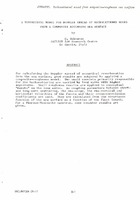| dc.contributor.author | Schwarze, Herward | |
| dc.date.accessioned | 2018-10-11T14:10:03Z | |
| dc.date.available | 2018-10-11T14:10:03Z | |
| dc.date.issued | 1975/10 | |
| dc.identifier | 303 | |
| dc.identifier.govdoc | CP-17/3 | |
| dc.identifier.uri | http://hdl.handle.net/20.500.12489/716 | |
| dc.description.abstract | For calculating the Doppler spread of acoustical reverberation from the sea surface, good results are achieved by applying a composite-roughness model. The small wavelets primarily responsible for the backscattering are carried by long waves with higher amplitudes 0 Small roughness results are applied to conceptual "facets" on the long waves. As coupling parameters between shortand long-wave scattering, the rms-slope, the rms-vertical and horizontal velocities of the facets and their cross-correlation coefficients are used. They are calculated from the covariance function of the sea surface as a function of the facet length. For a Pierson-Moscowitz spectrum, some computer results are given. | |
| dc.format | 9 p. : ill. ; digital, PDF file | |
| dc.language | English | |
| dc.publisher | NATO. SACLANTCEN | |
| dc.source | In: Ocean Acoustic Modelling (SACLANTCEN Conference Proceedings CP-17), Part 3, 1975, pp. 8-1 - 8-9. | |
| dc.subject | Acoustic reverberation | |
| dc.subject | Sea surface | |
| dc.subject | Acoustic models | |
| dc.subject | Acoustic scattering - Seafloor and sea surface | |
| dc.title | A theoretical model for doppler spread of backscattered sound from a composite roughness sea surface | |
| dc.type | Papers and Articles | |
| dc.type | Conference Proceedings (CP) | |
